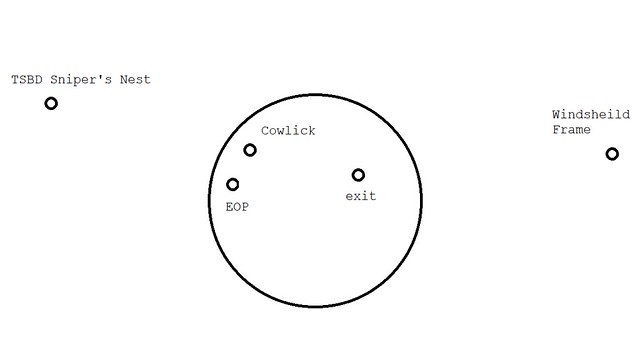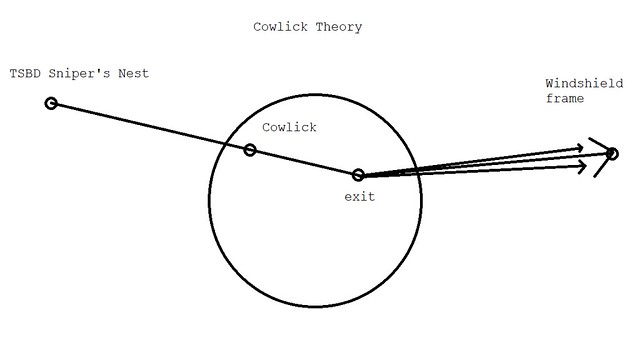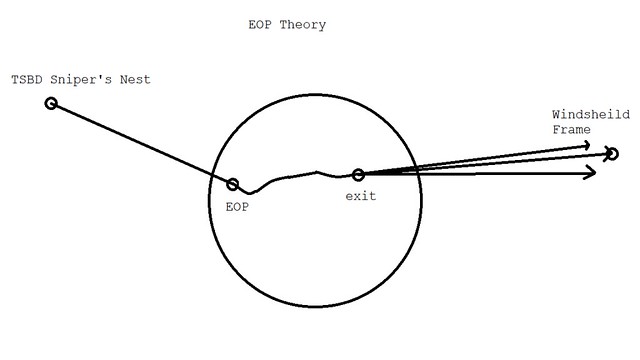The following diagrams are crude but make it simpler to see how the HSCA was drawn to a false Cowlick entry theory:

This shows:
** the direction of a shot from the sniper?s next
** a possible EOP entry location
** a possible Cowlick entry location
** the exit wound location
** the direction of the windshield frame, roughly where the fragments ended up striking
One fragment hit the windshield frame. Another hit a several inches lower, on the windshield itself. The largest fragment, 60% of the bullet, went on to slightly wound Mr. Tague, without (I believe) first striking the curb.
The HSCA looked at this and noticed that the (1) TSBD Sniper?s nest, (2) EOP entry wound, (3) Exit wound, did not line up. This caused them to closely look at the ?Cowlick? location, which would line up. And seeing what they expected to see, they found such a wound. And concluded the autopsy doctors must have been mistaken.
But they should have noticed that other locations did not line up. The crack in the windshield. The dent in the windshield frame. Nor the path required to hit Mr. Tague. Clearly, the bullet, or the bullet fragments, must deviate from a straight line, somewhere along the path. So, there is no compelling reason to insist that the entrance wound must be at a location that lines up.
Below is a diagram of the cowlick theory:
Cowlick Theory:

There is a nice straight line from the sniper?s nest, through the cowlick, to the exit location. But not to the windshield frame. If this theory is true, there was no deflection caused by entering the skull, but there was a large deflection caused by exiting the skull. No ballistic expert would expect this, I believe.
Below is a diagram of the EOP theory:
EOP Theory:

Upon entering the skull, the bullet starts to fragment. This is because the bullet (unlike the bullet that struck both JFK and Connally at z222) struck bone, the skull, with about 90% of its initial muzzle velocity. The distorted bullet and/or fragments curve a good deal more than an intact bullet. This has been demonstrated in ballistic tests using ballistic gel.
Within a millisecond, while still within the head, the bullet fragmented into two and then at least 3 parts. The fragments would be rotating and the axis of rotation would be changing. The fragments would follow unpredictable curved paths. Throughout much of the path through the head, the bullet must have held together, while fragmenting, resulting in an upward curve. The direction of the curve was random. Once the fragments became separated, each fragment was free to follow its own path.
This is the path a ballistic expert would expect a bullet to follow. Not a straight line through the skull, then an abrupt, angular deflection upon exiting. One can learn about this from reading Larry Sturdivan?s book ?The JFK Myths?.
While there are any number of CTers who would disagree with this and claim this is not how bullets behave, I have never heard of any ballistic expert in the world, an expert who runs tests with bullets and ballistic gel (like Larry Sturdivan), who would disagree with Mr. Sturdivan. As a bullet fragments, the fragments follow unpredictable curved paths through a ballistic gel, or a body.